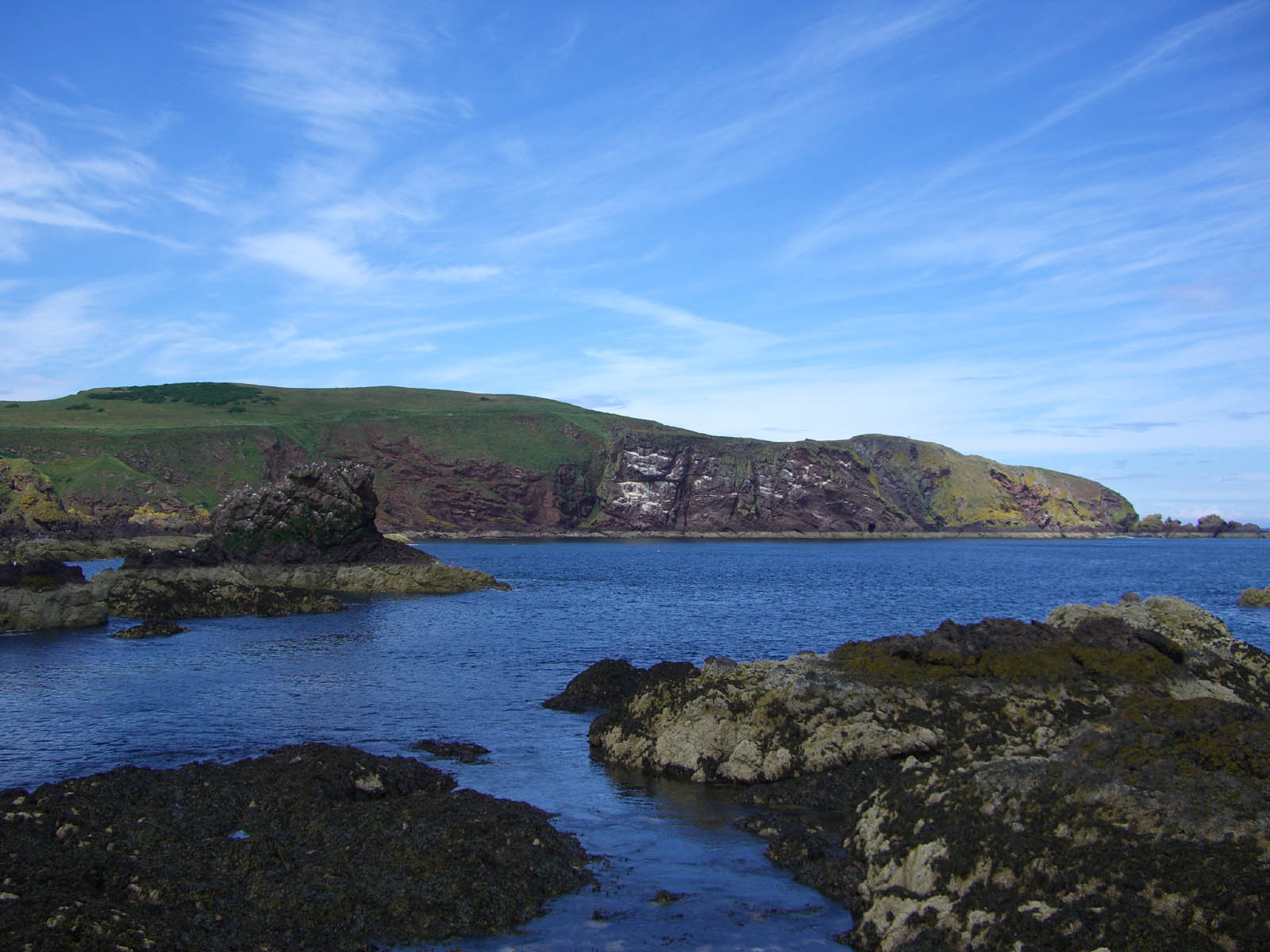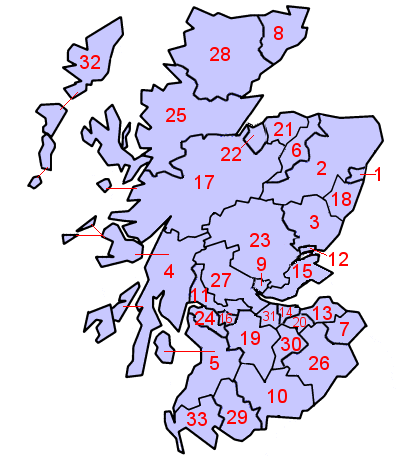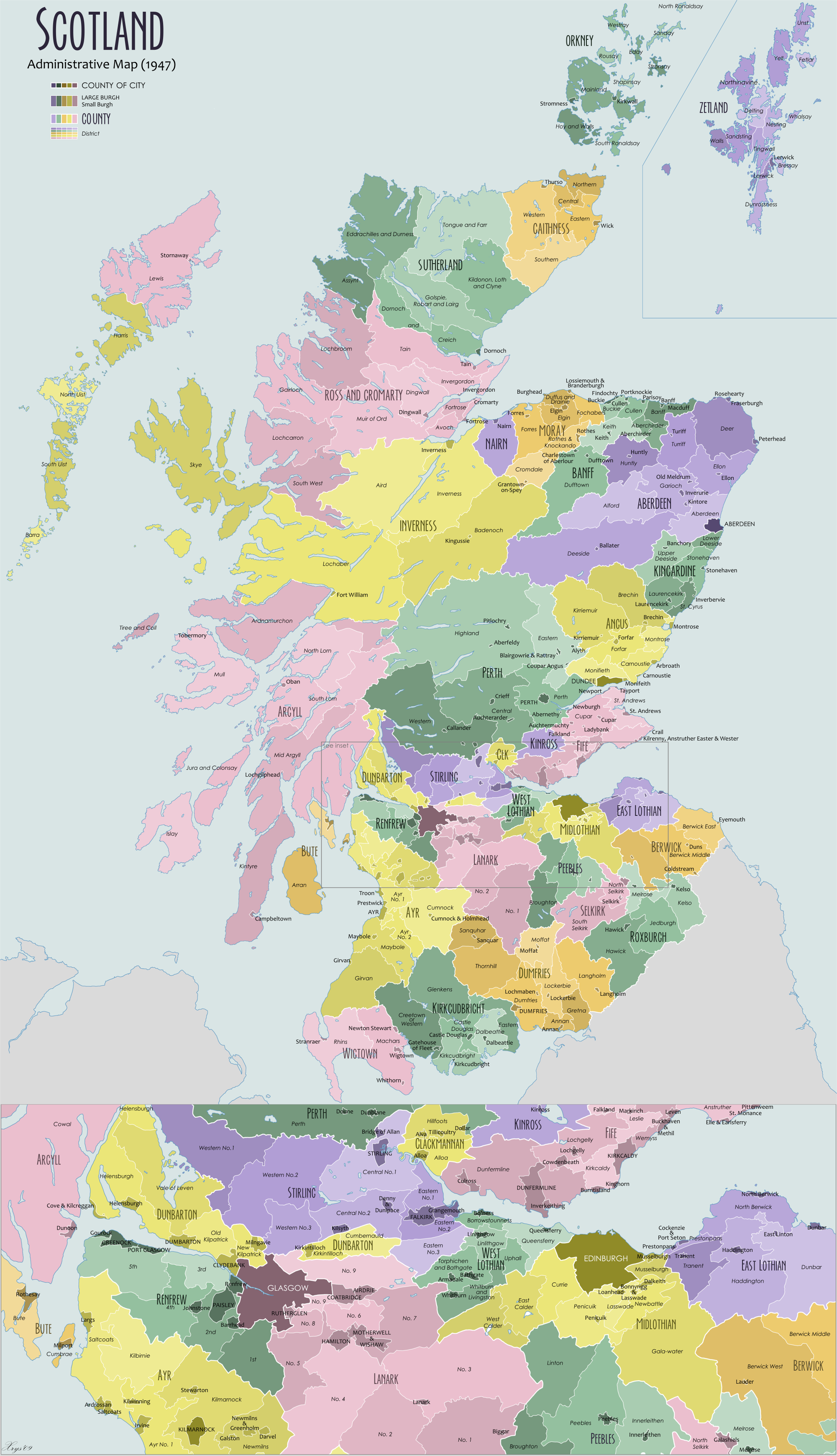|
Berwickshire
Berwickshire (; ) is a historic county, registration county and lieutenancy area in south-eastern Scotland, on the English border. The county takes its name from Berwick-upon-Tweed, its original county town, which was part of Scotland at the time of the county's formation in the twelfth century, but became part of England in 1482 after several centuries of swapping back and forth between the two kingdoms. After the loss of Berwick, Duns and Greenlaw both served as county town at different periods. Berwickshire County Council existed from 1890 until 1975, when the area became part of the Borders region, with most of the historic county becoming part of the lower-tier Berwickshire district. Berwickshire district was abolished in 1996, when all the districts in the Borders region merged to become the Scottish Borders council area. The low-lying part of Berwickshire between the Tweed and the Lammermuirs is known as "the Merse", from an old Scots word for a floodplain, and ... [...More Info...] [...Related Items...] OR: [Wikipedia] [Google] [Baidu] |
Duns, Scottish Borders
Duns is a town in the Scottish Borders, Scotland. It was the county town of the Shires of Scotland, historic county of Berwickshire. History Early history Duns Law, the original site of the town of Duns, has the remains of an Iron Age hillfort at its summit. Similar structures nearby, such as the structure at Edin's Hall Broch, suggest the area's domestic and defensive use at a very early stage. Middle ages Despite the town most likely dating its origins back to the 1000s, the first written mention of Duns is prior to 1179, when a 'Hugo de Duns' witnessed a charter of Roger d'Eu, of a grant of the benefice of the church of Gavinton, Berwickshire, Langton to Kelso Abbey. The town is further mentioned when a 'Robert of Douns' signed the Ragman Roll in 1296. The early settlement was sited on the slopes of Duns Law, close to the original Duns Castle built in 1320 by the Thomas Randolph, 1st Earl of Moray, Earl of Moray, nephew of Robert the Bruce. The town was frequently attacked ... [...More Info...] [...Related Items...] OR: [Wikipedia] [Google] [Baidu] |
Greenlaw
Greenlaw is a town and civil parish situated in the foothills of the Lammermuir Hills on Blackadder Water at the junction of the A697 and the A6105 in the Scottish Borders area of Scotland. At the 2001 census, the parish had a population of 661. History Greenlaw was first made the county town of Berwickshire in 1596. At that time, Greenlaw was situated about south of the present village, atop a hill - the 'Green Law'. This area is now known as Old Greenlaw. In 1661, county town status was lost to Duns by an act of Parliament, the Duns Act 1661 (c. 136). When Patrick, Earl of Marchmont attained the barony of Greenlaw in the 1670s, he made it his business to restore what he saw as the rights and privileges that came with the barony. In 1696 he succeeded: an act of Parliament, the (c. 16), was passed, laying down in statute that the town of Greenlaw should be the Head Burgh of Berwickshire. However, attempts were made in 1739, 1790 and 1810 to take the rights and privi ... [...More Info...] [...Related Items...] OR: [Wikipedia] [Google] [Baidu] |
Scottish Borders
The Scottish Borders is one of 32 council areas of Scotland. It is bordered by West Lothian, Edinburgh, Midlothian, and East Lothian to the north, the North Sea to the east, Dumfries and Galloway to the south-west, South Lanarkshire to the west, and the English Ceremonial counties of England, ceremonial counties of Cumbria and Northumberland to the south. The largest settlement is Galashiels, and the administrative centre is Newtown St Boswells. The term "Scottish Borders" is also used for the areas of southern Scotland and northern England that bound the Anglo-Scottish border, namely Dumfries and Galloway, Scottish Borders, Northumberland, and Cumbria. The council area occupies approximately the same area as the Shires of Scotland, historic shires of Berwickshire, Peeblesshire, Roxburghshire, and Selkirkshire. History The term Border country, Borders sometimes has a wider use, referring to all of the Counties of Scotland, counties adjoining the English border, also includin ... [...More Info...] [...Related Items...] OR: [Wikipedia] [Google] [Baidu] |
Whiteadder Water
Whiteadder Water is a river in East Lothian and Berwickshire, Scotland. It also flows for a very short distance through Northumberland before joining the River Tweed. In common with the headwaters of the Biel Water it rises on the low hillside of Clints Dod () in the Lammermuir Hills, just ESE of Whitecastle Hillfort and south-east of the village of Garvald. Etymology ''Adder'' may be derived from Brittonic ''*ador, *edir'' or Old English ''edre'', possible ancient hydronymic terms derived from an Indo-European formation meaning "a watercourse, a channel" (compare River Etherow). The possibility of the name deriving from Old English ''ǣdre'', "a vein" ( Anglian ''ēdre''), or ''*ǣdre'', meaning "quickly" is objected on the grounds that these would have maintained the long initial vowel in English and Scots. Also suggested is derivation from Gaelic ''fad dûr'', meaning "long water". though the Gaelic was never spoken in the Scottish southeast. Course The stream wend ... [...More Info...] [...Related Items...] OR: [Wikipedia] [Google] [Baidu] |
Berwick-upon-Tweed
Berwick-upon-Tweed (), sometimes known as Berwick-on-Tweed or simply Berwick, is a town and civil parish in Northumberland, England, south of the Anglo-Scottish border, and the northernmost town in England. The 2011 United Kingdom census recorded Berwick's population as 12,043. The town is at the mouth of the River Tweed on the east coast, south east of Edinburgh, north of Newcastle upon Tyne, and north of London. Uniquely for England, the town is slightly further north than Denmark's capital Copenhagen and the southern tip of Sweden, further east of the North Sea, which Berwick borders. Berwick was founded as an Anglo-Saxon settlement in the Kingdom of Northumbria, which was annexed by England in the 10th century. A civil parishes in England, civil parish and town council were formed in 2008 comprising the communities of Berwick, Spittal, Northumberland, Spittal and Tweedmouth. It is the northernmost civil parish in England. For more than 400 years, the area was central t ... [...More Info...] [...Related Items...] OR: [Wikipedia] [Google] [Baidu] |
Anglo-Scottish Border
The Anglo-Scottish border runs for between Marshall Meadows Bay on the east coast and the Solway Firth in the west, separating Scotland and England. The Firth of Forth was the border between the Picto- Gaelic Kingdom of Alba and the Anglian Kingdom of Northumbria in the early 10th century. It became the first Anglo-Scottish border with the annexation of Northumbria by Anglo-Saxon England in the mid-10th century. In 973, the Scottish king Kenneth II attended the English king Edgar the Peaceful at Edgar's council in Chester. After Kenneth had reportedly done homage, Edgar rewarded Kenneth by granting him Lothian. Despite this transaction, the control of Lothian was not finally settled and the region was taken by the Scots at the Battle of Carham in 1018 and the River Tweed became the '' de facto'' Anglo-Scottish border. The Solway–Tweed line was legally established in 1237 by the Treaty of York between England and Scotland. It remains the border today, with the exc ... [...More Info...] [...Related Items...] OR: [Wikipedia] [Google] [Baidu] |
Blackadder Water
Blackadder Water () is a river in Berwickshire in the Scottish Borders area of Scotland, forming part of the River Tweed system. It reached 2.84m at Mouthbridge, which was its highest level ever recorded on Tuesday 22 October 2002 at 2:45pm. Etymology ''Adder'' may be derived from Common Brittonic, Brittonic ''*ador'' or ''*edir'', or Old English ''wikt:ǣdre, ǣdre'', possible ancient hydronymic terms derived from an Indo-European formation meaning "a watercourse, a channel" (compare River Etherow). From the possible Old English derivation of ''ǣdre'', "a vein" (Old English#Dialects, Anglian ''ēdre''), or ''*ǣdre'', meaning "quickly", arise objections on the basis that these would have maintained the long initial vowel in English language, English and Scots language, Scots. Also suggested is derivation from Scottish Gaelic, Gaelic ''fad dûr'', meaning "long water". Course Rising in the Harecleugh Forest plantation just south of the Twin Law cairns, north of the village of W ... [...More Info...] [...Related Items...] OR: [Wikipedia] [Google] [Baidu] |
Lieutenancy Areas Of Scotland
The lieutenancy areas of Scotland are the areas used for the ceremonial lord-lieutenants, the British monarch, monarch's representatives, in Scotland. The lord-lieutenants' titles chosen by the British monarch, monarch and his legal advisers are mainly based on placenames of the traditional counties of Scotland. In 1794, permanent lieutenancies were established by Warrant (law), Royal Warrant. By the Militia Act 1797 (37 Geo.3, C.103), the lieutenants appointed "for the Counties, Stewartries, Cities, and Places" were given powers to raise and command County Militia Units. While in their lieutenancies, lord lieutenants are among the few individuals in Scotland officially permitted to fly Royal Banner of Scotland, a banner of the Royal Arms of Scotland, the "Lion Rampant" as it is more commonly known. Lieutenancy areas are different from the current local government of Scotland, local government council areas and their committee areas. They also differ from other subdivisions of Sc ... [...More Info...] [...Related Items...] OR: [Wikipedia] [Google] [Baidu] |
Shires Of Scotland
The counties or shires of Scotland () were historic subdivisions of Scotland. The shires were originally established in the Middle Ages for judicial purposes, being territories over which a Sheriff principal, sheriff had jurisdiction. They were distinct from the various older mormaerdoms, earldoms and other territories into which Scotland was also divided, which are collectively termed the provinces of Scotland by modern historians. The provinces gradually lost their functions, whereas the shires gradually gained functions. From the 16th century, the shires served as county constituency, constituencies, electing shire commissioners to the Parliament of Scotland. From 1667 each shire had Commissioners of Supply, commissioners of supply responsible for collecting local taxes; the commissioners of supply were subsequently given various local government functions as well. From 1797, the shires also served as areas for organising the militia, which was the responsibility of a lord-li ... [...More Info...] [...Related Items...] OR: [Wikipedia] [Google] [Baidu] |
Roxburghshire
Roxburghshire or the County of Roxburgh () is a historic county and registration county in the Southern Uplands of Scotland. It borders Dumfriesshire to the west, Selkirkshire and Midlothian to the northwest, and Berwickshire to the north. To the southwest it borders Cumberland and to the southeast Northumberland, both in England. It was named after the Royal Burgh of Roxburgh, a town which declined markedly in the 15th century and is no longer in existence. Latterly, the county town of Roxburghshire was Jedburgh. The county has much the same area as Teviotdale, the basin drained by the River Teviot and tributaries, together with the adjacent stretch of the Tweed into which it flows. The term is often treated as synonymous with Roxburghshire, but may omit Liddesdale as Liddel Water drains to the west coast.Ordnance Gazetteer of Scotland, by, Francis Groome, publ. 2nd edition 1896. Article on Roxburghshire History The county appears to have originated in the 12th centu ... [...More Info...] [...Related Items...] OR: [Wikipedia] [Google] [Baidu] |
East Lothian
East Lothian (; ; ) is one of the 32 council areas of Scotland, as well as a Counties of Scotland, historic county, registration county and Lieutenancy areas of Scotland, lieutenancy area. The county was called Haddingtonshire until 1921. In 1975, the historic county was incorporated for local government in Scotland, local government purposes into Lothian Regional Council, Lothian Region as East Lothian District, with some slight alterations of its boundaries. The Local Government etc. (Scotland) Act 1994 later created East Lothian as one of 32 modern council areas. East Lothian lies south of the Firth of Forth in the eastern central Lowlands of Scotland. It borders Edinburgh to the west, Midlothian to the south-west and the Scottish Borders to the south. Its administrative centre and former county town is Haddington, East Lothian, Haddington while the largest town is Musselburgh. Haddingtonshire has ancient origins and is named in a charter of 1139 as ''Hadintunschira'' and ... [...More Info...] [...Related Items...] OR: [Wikipedia] [Google] [Baidu] |
Council Areas
For local government purposes, Scotland is divided into 32 areas designated as "council areas" (), which are all governed by single-tier authorities designated as "councils". They have the option under the Local Government (Gaelic Names) (Scotland) Act 1997 of being known (but not re-designated) as a "''comhairle''" when opting for a Gaelic name; only ''Comhairle nan Eilean Siar'' (Council of the Western Isles) has chosen this option, whereas the Highland Council (''Comhairle na Gàidhealtachd'') has adopted its Gaelic form alongside its English equivalent, informally. The council areas have been in existence since 1 April 1996, under the provisions of the Local Government etc. (Scotland) Act 1994. Historically, Scotland was divided into 34 counties or shires. Although these no longer have any administrative function, they are still used to some extent in Scotland for cultural and geographical purposes, and some of the current council areas are named after them. There are al ... [...More Info...] [...Related Items...] OR: [Wikipedia] [Google] [Baidu] |








